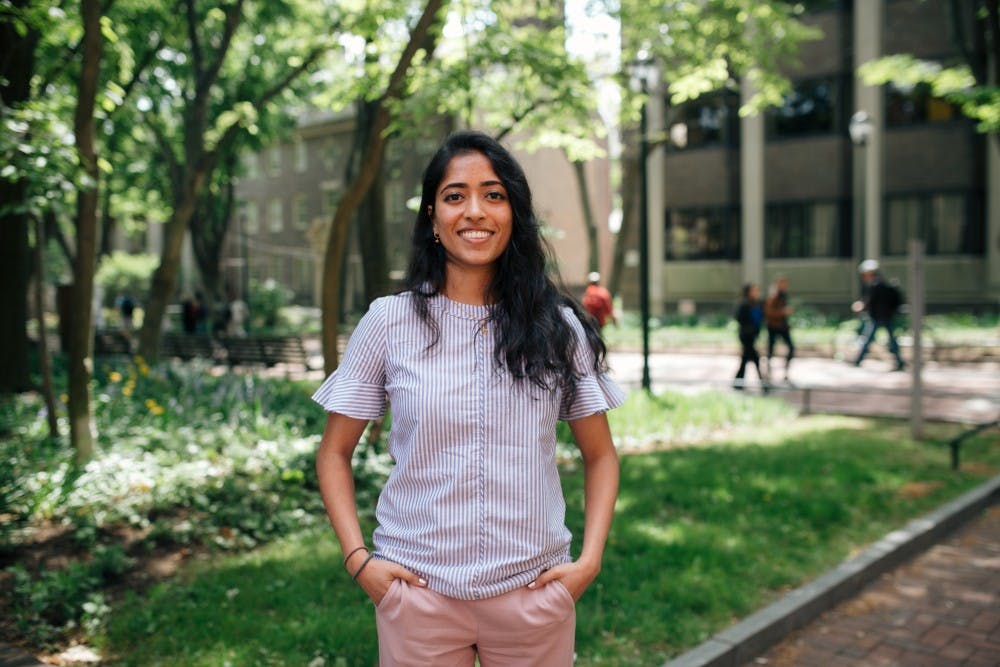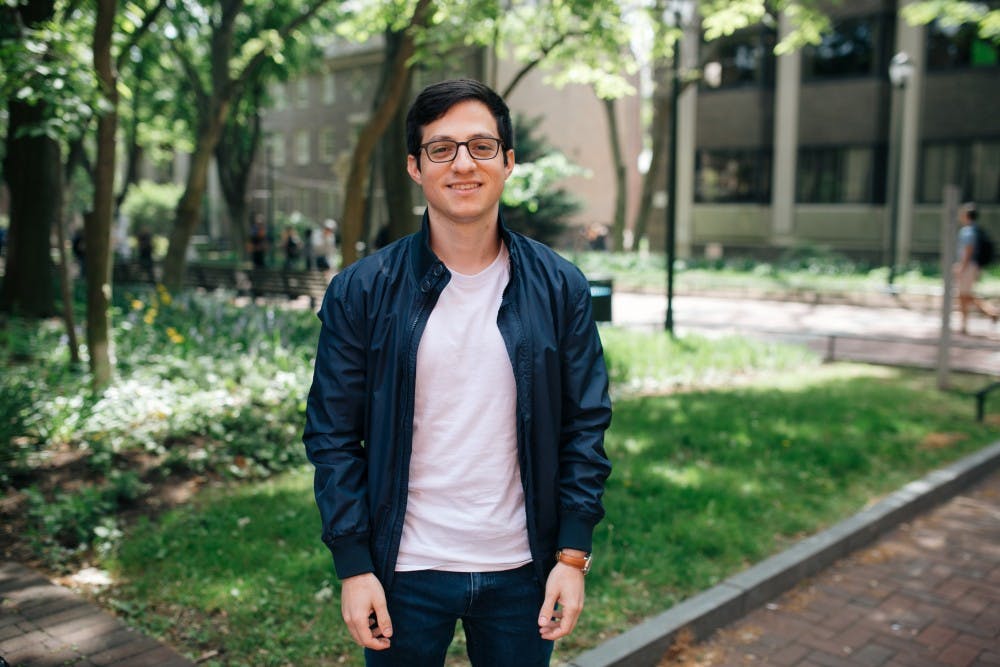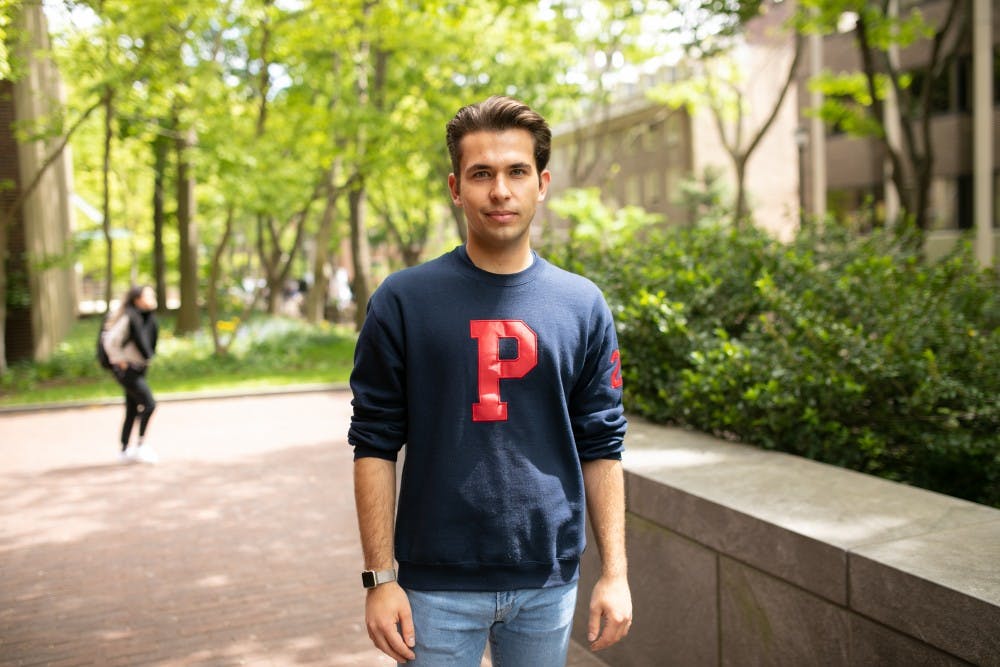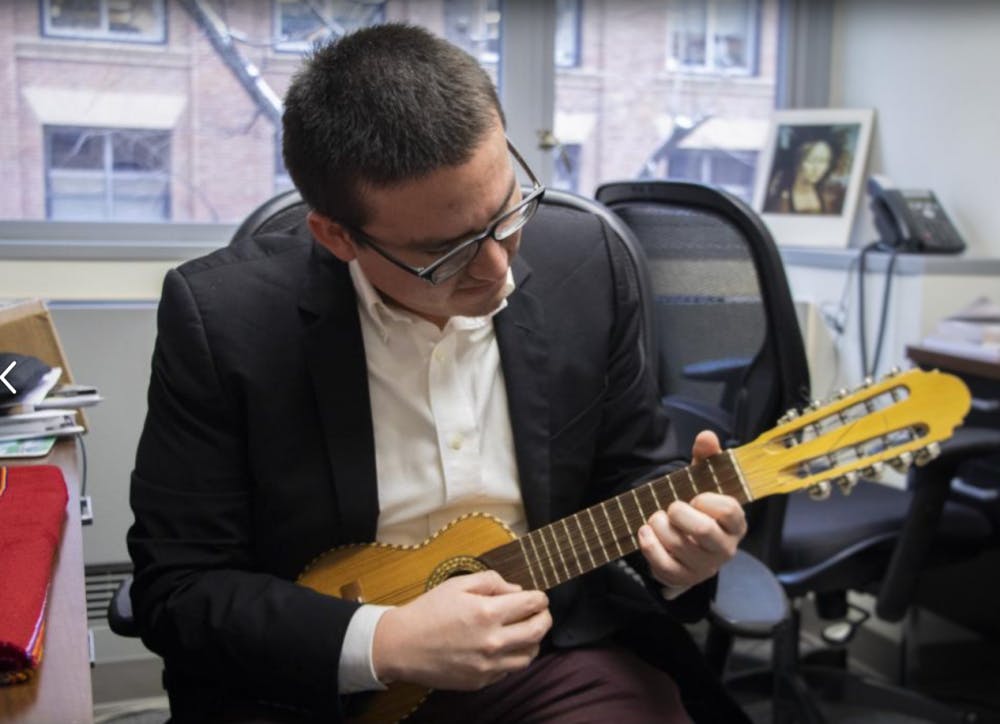On the first day of Elementary Quechua I, Debbie Rabinovich (C’ 19), a beaming, curly–haired senior, remembers her professor pulling up slides before turning to her and her five other classmates.
“Okay everyone,” said professor Américo Mendoza–Mori, a goateed man with an energetic seriousness to him. “We’re going to do something now. It’s called a ‘language shock.’” Then, he launched into his lecture in full, fluent Quechua.
Debbie exchanged looks with her classmates. They were as lost as she was. Everyone in the room spoke Spanish, but most of them, including Debbie, had had almost no exposure to Quechua, an indigenous language from the Andean region in Latin America. Debbie’s grandfather had spoken it, but he died when she was young. Her parents, who grew up in the Peruvian capital of Lima, did not grow up around the language. To them, it was something of a relic. They did not understand their daughter’s desire to learn a language that is not widely spoken outside of its geographic origin.
But for Debbie, that language was a part of her identity. She also felt an urgency to learn it: Quechua was, as she puts it, “one generation out from being lost in my family.”
She first heard that Penn offered Quechua in her sophomore year. She majors in Urban Studies and Gender Studies, and minors in Latin American and Latino Studies, Anthropology, and Religious Studies, so it was difficult to fit it into her schedule until her last semester.

Even then, she was having trouble getting the classes she needed for two of her minors, but she knew that if she had to choose, she would rather take Quechua. Now a senior, she sometimes pauses when she sees the language requirements on job postings: ‘Spanish required, French desirable.’ She wonders then if she maybe should have taken French.
“The answer is always no,” she tells me. “French would maybe be more marketable, but nowhere near as fulfilling.”
There are six people in Debbie’s class. Some language classes have as few as two or three students. These smaller classes, which fall outside the usual options of Spanish, French, and sometimes German, are known as Less Commonly Taught Languages—a sweeping category that is applied to languages relatively unfamiliar to American classrooms.
The Penn Language Center, borne out of a need for instructors in these languages, has been supporting Less Commonly Taught Languages for the past thirty years. While these classes once attracted mainly researchers such as anthropologists and linguists, they now also draw in students who identify in some way with the language’s culture, known as “heritage speakers.”
Often, taking these classes means meeting in Williams at odd hours and piling on an extra credit to an already overflowing schedule. Lecturers, who may hold other full–time positions as music teachers or hospital technicians, are usually employed on a part–time basis. While there are challenges to learning languages without easy access to Duolingo platforms and subtitled Netflix movies, the classrooms of less commonly taught languages have become centers for heritage learners to reconnect with a part of their identity, whether that means speaking the language they used growing up at home, or understanding a grandparent’s language for the first time.
Christina Frei, a forthright, spectacled German professor and the academic director of the Penn Language Center, says she wants to stop the world from becoming flat. “In that regard, I think we’re moving backwards,” she says bluntly. “We’re going back to the middle ages.”

In a world where people, businesses, and governments across the earth are increasingly connected, Frei observes that the English language dominates research and commerce. She calls it a pitfall of globalization. “I use that word because it’s a buzzword,” she adds. “Everybody’s a ‘global citizen,’ ‘global mission,’ you know, ‘Penn Global,’ ‘global seminars,’ it’s all global. We even use it: ‘Go global with Penn Language Center!’”
But the downside of this globalism is that language diversity has been falling fast.
Penn has always been a pioneer in the field of languages. It was the first postsecondary school in the US to offer a modern foreign language—German—as opposed to only Ancient Greek and Latin. The department’s history can be traced back to Philadelphia’s strong German presence beginning in the 17th century.
Then, departments like the Romance Language department and the Oriental Studies department (today divided into more specific areas covering the Middle East and Asia) began offering their own language courses, mostly with a literary focus.
The Penn Language Center emerged in 1989 to find and pay for part–time lecturers to teach less commonly taught languages that were not offered by existing departments. Today, the Center continues to pay for and employ instructors in languages that departments need, but don’t necessarily have the resources to provide. So while the South Asian Studies department administers—in other words, pays for—Hindi, the dominant language in India, the Penn Language Center administers other languages including Tamil, Telugu, and others.
After 9/11, the government began funneling money into programs for less commonly taught languages—including Arabic, Pashto, Mandarin Chinese, and Russian—through the National Flagship Language Initiative. This coincided with a new approach to language learning, one that would enable learners to speak and function in the language rather than primarily reading and translating.
Today, the key word in Penn’s language–learning is “communicative approach”—that is, an approach to the language that is linked to its culture, context, and community. Hence why Spanish 130 students are sent off to create “cultural diaries” and film themselves interacting with Spanish speakers in Philadelphia.
Something else has changed: More and more, the students taking these classes are heritage speakers rather than researchers. Now, many of the classes offered at the Penn Language Center began with the students themselves. For example, Quechua and Haitian Creole were both offered because a group of undergraduate students told the center that they wanted to learn it.
Frei says that at least five to six students need to be interested. She is firm on that point: “The students need to initiate it.”
For instance, the center just received a grant from the National Endowment for the Humanities to teach a Native American language at Penn. Frei will be meeting with students in order to decide which language it will be. “What do the students want? Which is the language that we should start with? We need to hear their voices.”
The next step is for the Center to find a part–time lecturer, someone who usually also has a full–time job and will get no benefits directly from the position. And then, of course, it’s important to make sure that the enrollments stay up, because once a class is cancelled, it is almost impossible to get it started again.
Unlike Debbie, Madhavi Muralidharan (C, W ’16), who will start at Penn Med in the fall, has always spoken the language she studies. There was always a 60–40 split, she estimates, between Tamil and English at home.

It was something she took for granted, until she came to Penn and realized that she had lost her main conversational partners in the language she had grown up with: her parents. She began making a more conscious effort to speak it on the phone to maintain her level of fluency.
Today, she’s in her fourth semester of Tamil, along with her fiancé, Lee Richman (C ’11), a current MD–Ph.D. student. Lee and Madhavi started taking Tamil two and a half years into their relationship. “I always knew that that was gonna be a requirement to make this thing work in the way we wanted it to work,” says Lee. He had met Madhavi’s parents, who immigrated to the United States from India in the ’80s. They are fluent in English, but Lee wanted to make the effort to speak to them in their language.
The bar is pretty low, he admits. “Even when I get stuff completely wrong, they just shower praise on me.”
Madhavi agrees teasingly. “It’s like, he says ‘Vanakkam’ [‘Hello/Welcome’], they’re like ‘Ahh! Genius!’”
But she also says that Lee is better than he gives himself credit for. “It’s gotten to the point where I can no longer talk to my parents about him in front of him, because he will pick up on key words.”
“I won’t know exactly what you’re saying, but I’ll know what you’re talking about.”
“Which is like, one of the main advantages of knowing another language!” she says with mock exasperation.
For Lee, learning Tamil has practical implications. And as the wedding approaches, he’s also nervous about all the people he will have to talk to. “Meeting family—I’m like deer in the headlights,” he says. Before meeting new relatives, they usually do a little practice beforehand, and then he’ll give shorter answers in order to try and stay “comprehensible.”

In the long term, he’s concerned about speaking the language if he and Madhavi ever start a family. He would want his children to be able to learn Tamil from both parents, not just from her.
As for Madhavi, Tamil class has been a space to learn about her culture and reflect on her own upbringing. She learned, for example, that the word you use for house depends on your caste: brahmins use “aathu,” while everyone else uses “vidu.” “I never knew that the way that I was speaking, that I just learned from listening to my parents, was actually putting out this message about my background,” she says.
Today, Madhavi and Lee are engaged, and are planning to get married in the summer of 2020.
“I would love to say something in Tamil at the wedding,” says Lee. “If we end up—”
“Really?” cuts in Madhavi, surprised.
“Well we’re not—not like a grand speech but like maybe—no?” He tries to read her expression. “Maybe not, I don’t know.”
“Oh, no, I didn’t know this,” says Madhavi, amused.
“I’m excited, I look forward to your speech.”
For heritage learners in less commonly taught languages, the communicative approach means seeing a new side of the culture. Professor Agnieszka Dziedzic, who teaches a Polish language and heritage class, takes her students on outings to watch movies or participate in events with the Polish–speaking community in North Philadelphia.
At the end of the fall semester, she and the university’s Polish club host a Christmas event, an important traditional supper, which attracts a throng of guests who mingle in both Polish and English. “These extra things are sometimes more important regular grammar stuff,” she says.
Dziedzic tries to make her class a welcoming place. As the mother of a Penn student, she is very understanding of the demands of university life. She has had students tell her that her’s is the only class they look forward to—that it gives them a special space in which to hear the language they grew up with at home. “For them, it’s the one course that might keep them well, in their minds,” she says.
Many of her students are first generation immigrants or sometimes even international students from Poland, who want to keep in touch with their language. Michal Kolakowski (W’ 20) grew up in Warsaw and attended a local high school. Wedged in with his six and a half credits, Polish is a lighter class that gives him the opportunity to converse in the language he grew up speaking, while also being able to pursue his interests like modern Polish literature. “There’s a lot of freedom,” he says. “Our professor gives us opportunities to learn what we want.”

For one Quechua class, Mendoza–Mori took his students to the Penn Museum to look at quipus, knots that are thought to have been used as a counting or classification system in the Andes but that have never been completely deciphered. He also took them to an exhibition at the Institute of Contemporary Art by Cecilia Vicuña, who uses quipus in her work.
Mendoza–Mori, who didn’t grow up speaking Quechua, says quipus are an example of indigenous knowledge that hasn’t been considered as valuable in traditional Western academia. Teaching Quechua is a step towards normalizing and integrating this kind of learning into that ivory tower. “Language can operate as a knowledge keeper,” he says. “We have to make it normal. [In universities] it’s still not normal to see—or common … to see Quechua, to see Chichewa, to see other languages that have been underrepresented."

Last year, the Quechua program obtained a small victory: its own course code. Now, students can look up QUEC on Penn InTouch, and there it is: Elementary Quechua I and II. Before that, the class code was under the Romance Language Department (although Quechua is not a romance language). The course also counts towards the Linguistics major and the Latin American and Latino Studies major, and graduate students can use it to fulfill their language requirements.
Making classes count in this way is crucial to boost continued enrollment, which is the only way a language program can survive at Penn. In the hectic administrative world of sectors, foundational approach courses, and major requirements, students don’t always find the time to dedicate to a language class, especially one that, like Quechua, does not fulfill the undergraduate language requirement.
“Our Penn students are very savvy,” notes Frei. “They do not waste time. Why would they? So it’s always a matter of deep love for the subject and really deep personal interest and engagement. But also—hey! This all costs money!”
Another impediment to learning is the lack of materials: In Spanish and French, there are a panoply of grammar books, apps, and beginner–level podcasts to draw from. Search for a Spanish phrase on a translation website and you’re likely to get several results. But for less commonly taught languages, these resources may be sparse or insufficient. For a language like Tamil, which has a big divide between the spoken and written versions, Google Translate is all but useless.
Still, there are opportunities that small language classes can offer as incentives, like access to scholarships and programs, and even trips: Recently, Debbie and some of her classmates travelled to New York to attend the United Nations’ Indigenous Forum. This is the “extra stuff” that Dziedzic keeps emphasizing: “If you were not in class, you would not get that.”
There’s a Quechua word that Debbie finds “kind of mind–blowing”: “ch’ixchi.”
It’s a word that refers to the singular color made by woven threads in a tapestry when you look at it from far away. The word is also used in Aymara (as “ch’ixi”), a neighboring indigenous language, to describe the Latinx community—in all its diverse complexity—in a way that decenters whiteness.
Learning these words and other cultural factoids gives Debbie “a weird sense of joy.” She has found aspects of her daily life that resonate with her Andean heritage—the suffix of endearment –chay, for example, a version of which she has always used to call her parents: Mamachay and Papachay. She often calls them after class to tell them about new words she’s learned that day. They can’t speak back to her in Quechua, but they like how happy it makes her.
But Debbie also sees her Quechua class as part of a larger task of personal remembrance. When Mendoza–Mori took them to see the quipus at the Penn Museum, she remembers their guide talking about about their destruction by the Inquisition in the 16th century—about how the Spanish knew their value, and thus burned them. Since then, no one has been able to decipher their meaning. Debbie felt a heaviness as she looked at the knots.
“My ancestors had their stories erased,” she says, and pauses. “And for me taking Quechua is a part of ... reclaiming indigeneity. Making that part of my heritage visible.”
